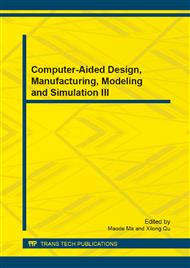[1]
M. C. Cavalcanti, K. C. Oliveira, G. M. S. Azevedo, F. A.S. Neves. Comparative study of maximum power point tracking techniques for photovoltaic systems, Revista Eletrônica de Potência, Brazilian Journal of Power Electronics, vol. 12, no. 2, pp.163-171, (2007).
DOI: 10.18618/rep.2007.2.163171
Google Scholar
[2]
T. Esram, P. L. Chapman, Comparison of photovoltaic array maximum power point tracking techniques, IEEE Transactions on Energy Conversion, vol. 22, no. 2, pp.439-449, (2007).
DOI: 10.1109/tec.2006.874230
Google Scholar
[3]
N. Femia, M. Fortunato, G. Lisi, G. Petrone, G. Spagnuolo, M. Vitelli. Guidelines for the optimization of the P&O technique in grid-connected double-stage photovoltaic systems,. IEEE International Symposium on Industrial Electronics, (2007).
DOI: 10.1109/isie.2007.4374986
Google Scholar
[4]
N. Femia, G. Petrone, G. Spagnuolo, M. Vitelli. Optimizing duty-cycle perturbation of P&O MPPT technique, IEEE 35th Power Electronics Specialists Conference, vol. 3, pp.1939-1944, (2004).
DOI: 10.1109/pesc.2004.1355414
Google Scholar
[5]
N. Femia, G. Petrone, G. Spagnuolo, M. Vitelli, Optimizing sampling rate of P&O MPPT technique,. IEEE 35th Annual Power Electronics Specialists Conference, vol. 3, pp.1945-1949, (2004).
DOI: 10.1109/pesc.2004.1355415
Google Scholar
[6]
N. Femia, G. Petrone, G. Spagnuolo, M. Vitelli, Optimization of perturb and observe maximum power point tracking method, IEEE Transactions on Power Electronics, vol. 20, no. 4, pp.963-973, (2005).
DOI: 10.1109/tpel.2005.850975
Google Scholar
[7]
K. H. Hussein et. Al., Maximum photovoltaic power tracking : an algorithm for rapidly changing atmospheric conditions, IEE Proceedings on Generation, Transmission and Distribution, (1995).
DOI: 10.1049/ip-gtd:19951577
Google Scholar
[8]
Syafaruddin, E. Karatepe, T. Hiyama, Artificial neural network-polar coordinated fuzzy controller based maximum power point tracking control under partially shaded conditions, IET Renewable Power Generation, vol. 3, no. 2, pp.239-253, (2009).
DOI: 10.1049/iet-rpg:20080065
Google Scholar
[9]
M. Miyatake, F. Toriumi, T. Endo, N. Fuji, A novel maximum power point tracker controlling several converters connected to photovoltaic arrays with particle swarm optimization technique, European Conference on Power Electronics and Applications, pp.1-10, (2007).
DOI: 10.1109/epe.2007.4417640
Google Scholar
[10]
M. Miyatake, T. Inada, I. Hiratsuka, Hongyan Zhao, H. Otsuka, M. Nakano, Control characteristics of a Fibonaccisearch-based maximum power point tracker when a photovoltaic array is partially shaded, International Power Electronics and Motion Control Conference, IPEMC, vol. 2, pp.816-821, (2004).
Google Scholar
[11]
G. Spiazzi, S. Buso, P. Mattavelli, Analysis of MPPT algorithms for photovoltaic panels based on ripple correlation techniques in presence of parasitic components, 10th Brazilian Power Electronics Conference, pp.88-95, (2009).
DOI: 10.1109/cobep.2009.5347738
Google Scholar
[12]
T. Esram, J.W. Kimball, P.T. Krein, P.L. Chapman, P. Midya, Dynamic maximum power point tracking of photovoltaic arrays using ripple correlation control, IEEE Transactions on Power Electronics, vol. 21, no. 5, pp.1282-1291, (2006).
DOI: 10.1109/tpel.2006.880242
Google Scholar
[13]
J.W. Kimball, P.T. Krein, Digital ripple correlation control for photovoltaic applications, Power Electronics Specialists Conference, pp.1690-1694, (2007).
DOI: 10.1109/pesc.2007.4342252
Google Scholar
[14]
J.W. Kimball and P.T. Krein. Discrete-time ripple correlation control for maximum power point tracking,. IEEE Transactions on Power Electronics, vol. 23, no. 5, pp.2353-2362, (2008).
DOI: 10.1109/tpel.2008.2001913
Google Scholar
[15]
M. M. Casaro, D. C. Martins, Modelo de arranjo fotovoltaico destinado a análises em eletrônica de potência via simulação,. Revista Eletrônica de Potência, Brazilian Journal of Power Electronics, vol. 13, no. 3, (2008).
DOI: 10.18618/rep.2008.3.141146
Google Scholar
[16]
M. G. Villalva, J. R. Gazoli, E. Ruppert, Comprehensive approach to modeling and simulation of photovoltaic arrays, IEEE Transactions on Power Electronics, vol. 24, pp.1198-1208, (2009).
DOI: 10.1109/tpel.2009.2013862
Google Scholar
[17]
M. G. Villalva, J. R. Gazoli, E. Ruppert. Modeling and circuit-based simulation of photovoltaic arrays., Revista Eletrônica de Potência, Brazilian Journal of Power Electronics, vol. 14, pp.35-45, (2009).
DOI: 10.18618/rep.2009.1.035045
Google Scholar
[18]
L. C. G. Lopes, Sistema experimental fotovoltaico de geração de energia elétrica operando em paralelo com a rede elétrica CA. Dissertação (Mestrado em Engenharia Elétrica), Universidade Federal de Juiz de Fora, (2006).
DOI: 10.37423/211105008
Google Scholar


